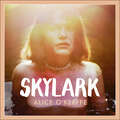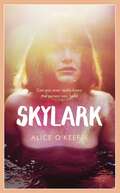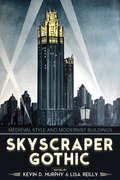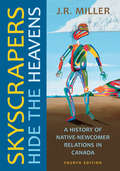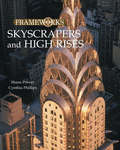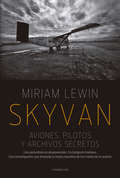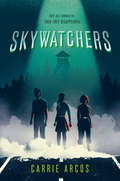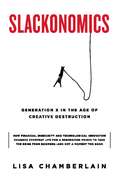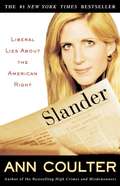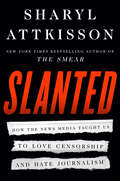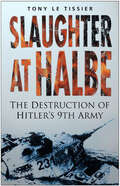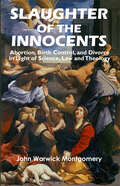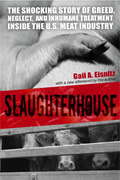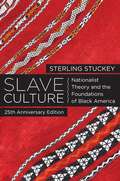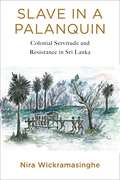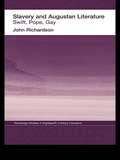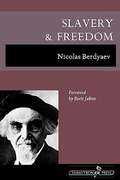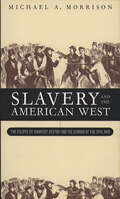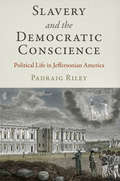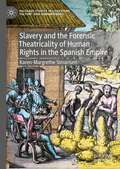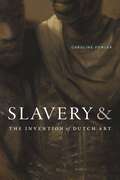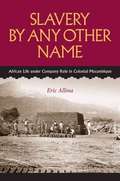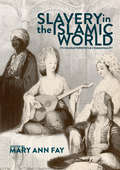- Table View
- List View
Skylark: THE COMPELLING NOVEL OF LOVE, BETRAYAL AND CHANGING THE WORLD
by Alice O'KeeffeTheir ideals brought them together, but how closely should you follow your heart?It's the mid-90s, and rebellion is in the air.Skylark is an activist, a raver, a tree-dweller, a world-changer.Handsome, dependable Dan appears on the scene, offering her the security she has never had. When they fall in love, she shows him a new way to live; he will never be the same.But Dan has a secret, which Skylark must never, ever know.A secret so powerful that its fault-lines run from their ordinary council flat right up to the highest echelons of the state.Their story is the story of Britain's undercover police.As Skylark comes to doubt not only Dan's commitment to their shared ideals, but his very identity, she finds herself asking: can you ever really know the person you love?(P) 2021 Hodder & Stoughton Limited
Skylark: The new novel from the author of ON THE UP
by Alice O'Keeffe'SKYLARK plunges the reader headfirst into a vivid, heady world where passion and betrayal collide. Beautifully-written, immersive and ultimately enraging, it's a must-read for anyone who has ever wanted to change the world.' - Erin Kelly'Alice O'Keeffe deftly renders the shocking truth of the spy cops scandal into a moving tale of love, identity and betrayal. Essential reading.' - Jake Arnott'Skylark is a book of profound psychological perception, which conjures with deft precision the atmosphere of the anti-roads movement in all its fierce, tender idealism. I couldn't put it down.' - Jay Griffiths Their ideals brought them together, but how closely should you follow your heart?It's the mid-90s, and rebellion is in the air.Skylark is an activist, a raver, a tree-dweller, a world-changer. Handsome, dependable Dan appears on the scene, offering her the security she has never had. When they fall in love, she shows him a new way to live; he will never be the same. But Dan has a secret, which Skylark must never, ever know. A secret so powerful that its fault-lines run from their ordinary council flat right up to the highest echelons of the state.Their story is the story of Britain's undercover police.As Skylark comes to doubt not only Dan's commitment to their shared ideals, but his very identity, she finds herself asking: can you ever really know the person you love?
Skylark: The new novel from the author of ON THE UP
by Alice O'Keeffe'SKYLARK plunges the reader headfirst into a vivid, heady world where passion and betrayal collide. Beautifully-written, immersive and ultimately enraging, it's a must-read for anyone who has ever wanted to change the world.' - Erin Kelly'Alice O'Keeffe deftly renders the shocking truth of the spy cops scandal into a moving tale of love, identity and betrayal. Essential reading.' - Jake Arnott'Skylark is a book of profound psychological perception, which conjures with deft precision the atmosphere of the anti-roads movement in all its fierce, tender idealism. I couldn't put it down.' - Jay Griffiths Their ideals brought them together, but how closely should you follow your heart?It's the mid-90s, and rebellion is in the air.Skylark is an activist, a raver, a tree-dweller, a world-changer. Handsome, dependable Dan appears on the scene, offering her the security she has never had. When they fall in love, she shows him a new way to live; he will never be the same. But Dan has a secret, which Skylark must never, ever know. A secret so powerful that its fault-lines run from their ordinary council flat right up to the highest echelons of the state.Their story is the story of Britain's undercover police.As Skylark comes to doubt not only Dan's commitment to their shared ideals, but his very identity, she finds herself asking: can you ever really know the person you love?
Skyscraper Gothic: Medieval Style and Modernist Buildings
by Kevin D. Murphy and Lisa ReillyOf all building types, the skyscraper strikes observers as the most modern, in terms not only of height but also of boldness, scale, ingenuity, and daring. As a phenomenon born in late nineteenth-century America, it quickly became emblematic of New York, Chicago, and other major cities. Previous studies of these structures have tended to foreground examples of more evincing modernist approaches, while those with styles reminiscent of the great Gothic cathedrals of Europe were initially disparaged as being antimodernist or were simply unacknowledged. Skyscraper Gothic brings together a group of renowned scholars to address the medievalist skyscraper—from flying buttresses to dizzying spires; from the Chicago Tribune Tower to the Woolworth Building in Manhattan.Drawing on archival evidence and period texts to uncover the ways in which patrons and architects came to understand the Gothic as a historic style, the authors explore what the appearance of Gothic forms on radically new buildings meant urbanistically, architecturally, and socially, not only for those who were involved in the actual conceptualization and execution of the projects but also for the critics and the general public who saw the buildings take shape.Contributors:Lisa Reilly on the Gothic skyscraper ● Kevin Murphy on the Trinity and U.S. Realty Buildings ● Gail Fenske on the Woolworth Building ● Joanna Merwood-Salisbury on the Chicago School ● Katherine M. Solomonson on the Tribune Tower ● Carrie Albee on Atlanta City Hall ● Anke Koeth on the Cathedral of Learning ● Christine G. O'Malley on the American Radiator Building
Skyscrapers Hide the Heavens: A History of Native-Newcomer Relations in Canada, Fourth Edition
by J. R. MillerFirst published in 1989, Skyscrapers Hide the Heavens continues to earn wide acclaim for its comprehensive account of Native-newcomer relations throughout Canada’s history. Author J.R. Miller charts the deterioration of the relationship from the initial, mutually beneficial contact in the fur trade to the current displacement and marginalization of the Indigenous population. The fourth edition of Skyscrapers Hide the Heavens is the result of considerable revision and expansion to incorporate current scholarship and developments over the past twenty years in federal government policy and Aboriginal political organization. It includes new information regarding political organization, land claims in the courts, public debates, as well as the haunting legacy of residential schools in Canada. Critical to Canadian university-level classes in history, Indigenous studies, sociology, education, and law, the fourth edition of Skyscrapers will be also be useful to journalists and lawyers, as well as leaders of organizations dealing with Indigenous issues. Not solely a text for specialists in post-secondary institutions, Skyscrapers Hide the Heavens explores the consequence of altered Native-newcomer relations, from cooperation to coercion, and the lasting legacy of this impasse.
Skyscrapers and High Rises (Frameworks (group 1) Ser.)
by Cynthia Phillips Shana PriwerThis work includes a brief history of skyscrapers as well as chapters on elevators and communications, facades and facing, mechanical and electrical systems, forces of nature, and much more.
Skyvan. Aviones, pilotos y archivos secretos: Una periodista es desaparecida. Un fotógrafo italiano. Una investigación que desnuda la trama macabra de los vuelos de la muerte
by Miriam LewinUna investigación única sobre los pilotos y los aviones que arrojaron desaparecidos al Río de la Plata por una de las sobrevivientes de los centros clandestinos y la ESMA. Decidida a conocer qué aviones y pilotos arrojaron al mar a detenidos-desaparecidos por la Dictadura, Miriam Lewin -con el fotógrafo italiano Giancarlo Ceraudo- identificó a los responsables de esos vuelos, ahora procesados. Skyvan cuenta cómo ambos localizan las naves desperdigadas por el mundo y reconstruyen sus historias: una estuvo a punto de convertirse en confitería, otra se usa para filmar rallies. En un Skyvan estacionado en Fort Lauderdale, Florida, se encontró documentación que, una vez descifrada, iluminó la pesquisa y llegó a los Tribunales. Años de investigaciones e intimidades permiten a la autora revisar su pasado juvenil -el que la llevó a la ESMA- y a su socio narrar su antifascismo. Relato también de una profunda amistad nacida de la búsqueda pertinaz de justicia, el apasionante libro de Miriam Lewin puede ser leído como un thriller, aquí subgénero de la mejor non-fiction. Isidoro Gilbert
Skywatchers
by Carrie ArcosFrom National Book Award Finalist Carrie Arcos comes a thrilling, genre-bending mystery about the history of the Cold War and the UFO phenomenon. Perfect for fans of In the Woods by Tana French and Netflix's Stranger Things.The year is 1952. The threat of invasion from the Soviet Union has people in a panic. The government has issued a call to civilians to act as radar--and Teddy, John, Caroline, Eleanor, Bunny, Frank, and Oscar eagerly answer. As members of their high school's "Operation Skywatch" club, they, along with others across the country, look to the sky in an effort to protect the country from attack. But they're not prepared for the strange green light they see when on duty, which looks like nothing they've been trained to look out for. So when the mysterious object lands in the forest, Teddy, John, Caroline, and Bunny go in to investigate. Then, they disappear. In this thrill of a novel inspired by real events, one group of teens will come face to face with the UFO phenomenon and the vastness of the unknown as they try to save one another, and possibly, the world. A powerful exploration of what if.Praise for Skywatchers:"The historical time period, astute character development, and suspense-filled writing will draw readers in." --Kirkus Reviews"An expertly crafted genre mash-up of sci-fi, historical fiction, and mystery, with a dash of thriller that will keep readers racing towards the end. A unique and original tale that will appeal to a wide variety of teens. A must-have for all teen collections." --School Library Journal
Slackonomics: Generation X in the Age of Creative Destruction
by Lisa ChamberlainGeneration X grew up in the 1980s, when Alex P. Keaton was going to be a millionaire by the time he was thirty, greed was good, and social activism was deader than disco. Then globalization and the technological revolution came along, changing everything for a generation faced with bridging the analog and digital worlds. Living in a time of “creative destruction” – when an old economic order is upended by a new one – has deeply affected everyday life for this generation; from how they work, where they live, how they play, when they marry and have children to their attitudes about love, humor, happiness, and personal fulfillment. Through a sharp and entertaining mix of pop and alt-culture, personal narrative, and economic analysis, author Lisa Chamberlain shows how Generation X has survived and even thrived in the era of creative destruction, but will now be faced with solving economic and environmental problems on a global scale.
Slander
by Ann Coulter"The immutable fact of politics in America is this: liberals hate conservatives." Ann Coulter, whose examination of the Clinton impeachment was a major national bestseller and earned widespread praise, now takes on an even tougher issue. At a time when Democrats and Republicans should be overwhelmingly congenial, American political debate has become increasingly hostile, overly personal, and insufferably trivial. Whether conducted in Congress or on the political talk shows, played out at dinners or cocktail parties, politics is a nasty sport. At the risk of giving away the ending: It's all liberals' fault. Cultlike in their behavior, vicious in their attacks on Republicans, and in almost complete control of mainstream national media, the left has been merciless in portraying all conservatives as dumb, racist, power hungry, homophobic, and downright scary. This despite the many Republican accomplishments of the last few decades, as well as the Bush administration's expert handling of the country's affairs in the wake of the worst attacks on American soil and of the war that followed. With incisive reasoning and meticulous research, Ann Coulter examines the events and personalities that have shaped modern political discourse-- the bickering, backstabbing, and name-calling that have made cultural mountains out of partisan molehills. She demonstrates how the media, especially, are biased-- and usually wrongheaded-- and have done all in their power to obfuscate the issues and the people behind them, bending over backward to villainize and belittle the right, while rarely missing an opportunity to praise the left. Perhaps if conservatives had had total control over every major means of news dissemination for a quarter century, they would have forgotten how to debate, too, and would just call liberals stupid and mean. But that's an alternative universe. In this universe, the public square is wall-to-wall liberal propaganda. Refreshingly honest and unerringly timely, Slander continues where Bernard Goldberg's number one bestselling Bias left off.
Slanted: How the News Media Taught Us to Love Censorship and Hate Journalism
by Sharyl AttkissonUSA TODAY BESTSELLER!New York Times bestselling author Sharyl Attkisson takes on the media’s misreporting on Black Lives Matter, coronavirus, Joe Biden, Silicon Valley censorship, and more.When the facts don’t fit their Narrative, the media abandons the facts, not the Narrative. Virtually every piece of information you get through the media has been massaged, shaped, curated, and manipulated before it reaches you. Some of it is censored entirely. The news can no longer be counted on to reflect all the facts. Instead of telling us what happened yesterday, they tell us what’s new in the prepackaged soap opera they’ve been calling the news.For the past four years, five-time Emmy Award–winning investigative journalist and New York Times bestselling author Sharyl Attkisson has been collecting and dissecting alarming incidents tracing the shocking devolution of what used to be the most respected news organizations on the planet. For the first time, top news executives and reporters representing every major national television news outlet—from ABC, CBS, NBC, and CNN to FOX and MSNBC—speak frankly, confiding in Attkisson about the death of the news as they once knew it. Their concern transcends partisan divides.Most frightening of all, a broad campaign in the media has convinced many Americans not only to accept but to demand censorship over journalism. It is a stroke of genius on the part of those seeking to influence public opinion: undermine public confidence in the news, then insist upon “curating” information and divining the “truth.” The thinking is done for you. They’ll decide which pesky facts shouldn’t cross your desk by declaring them false, irrelevant, debunked, unsafe, or out-of-bounds.We have reached a state of utter absurdity, where journalism schools teach students that their own, personal truth or chosen narratives matter more than reality. In Slanted, Attkisson digs into the language of propagandists, the persistence of false media narratives, the driving forces behind today's dangerous blend of facts and opinion, the abandonment of journalism ethics, and the new, Orwellian definition of what it means to report the news.
Slaughter at Halbe: The Destruction of Hitler's 9th Army April 1945
by Tony TissierOperation ‘Berlin’, the Soviet offensive launched on 16 April 1945 by Marshals Zhukov and Koniev, isolated the German 9th Army and tens of thousands of refugees in the Spreewald ‘pocket’, south-east of Berlin. Stalin ordered its encirclement and destruction, and his subordinates, eager to win the race to the Reichstag, pushed General Busse’s 9th Army into a tiny area east of the village of Halbe.To escape the Spreewald pocket, the remnants of 9th Army had to pass through Halbe, where barricades constructed by both sides formed formidable obstacles and the converging Soviet forces subjected the area to heavy artillery fire. By the time 9th Army eventually escaped the Soviet pincers, it had suffered 40,000 killed and 60,000 taken prisoner.In Slaughter at Halbe, teenaged refugees recount their experiences alongside Wehrmacht and Waffen-SS veterans attempting to maintain military discipline amid the chaos and carnage of headlong retreat. Relating the story day by day, Tony Le Tissier shows the impact of total war upon soldier and civilian alike.
Slaughter of the Innocents: Abortion, Birth Control, & Divorce in Light of Science, Law & Theology
by John Warwick MontgomeryDr. Montgomery examines some of the most tragic and divisive issues facing Christians today—abortion, divorce, and birth control. Drawing from a wealth of knowledge and reflection on the moral, ethical, theological, medical, and legal aspects of his topics, Dr. Montgomery sheds new and invaluable light on the issues.
Slaughterhouse
by Gail A. EisnitzSlaughterhouse is the first book of its kind to explore the impact that unprecedented changes in the meatpacking industry over the last twenty-five years -- particularly industry consolidation, increased line speeds, and deregulation -- have had on workers, animals, and consumers. It is also the first time ever that workers have spoken publicly about what's really taking place behind the closed doors of America's slaughterhouses.In this new paperback edition, author Gail A. Eisnitz brings the story up to date since the book's original publication. She describes the ongoing efforts by the Humane Farming Association to improve conditions in the meatpacking industry, media exposés that have prompted reforms resulting in multimillion dollar appropriations by Congress to try to enforce federal inspection laws, and a favorable decision by the Supreme Court to block construction of what was slated to be one of the largest hog factory farms in the country.Nonetheless, Eisnitz makes it clear that abuses continue and much work still needs to be done.
Slave Culture: Nationalist Theory and the Foundations of Black America
by Sterling StuckeyIn this book, the author explains how different African peoples interacted on the plantations of the South to achieve a common culture. He argues that at the time of emancipation, slaves still remained essentially African in culture, a conclusion that has had profound implications for theories of black liberation and race relations in America. Drawing evidence from the anthropology and art history of Central and West African cultural traditions and exploring the folklore of the American slave, the author reveals an intrinsic Pan-African impulse that contributed to the formation of the black ethos in slavery. He presents fascinating profiles of such nineteenth-century figures as David Walker, Henry Highland Garnet, and Frederick Douglass, as well as detailed examinations into the lives and careers of W.E.B. Du Bois and Paul Robeson in this century. The second edition, which includes a Foreword by historian John Stauffer, will reintroduce the author's masterpiece to a wider audience. The author provides a new introduction that looks at the life of the book and the impact it has had on the field of African-American scholarship, as well as how the field has changed in the 25 years since its original publication.
Slave in a Palanquin: Colonial Servitude and Resistance in Sri Lanka
by Nira WickramasingheFor hundreds of years, the island of Sri Lanka was a crucial stopover for people and goods in the Indian Ocean. For the Dutch East India Company, it was also a crossroads in the Indian Ocean slave trade. Slavery was present in multiple forms in Sri Lanka—then Ceylon—when the British conquered the island in the late eighteenth century and began to gradually abolish slavery. Yet the continued presence of enslaved people in Sri Lanka in the nineteenth century has practically vanished from collective memory in both the Sinhalese and Tamil communities.Nira Wickramasinghe uncovers the traces of slavery in the history and memory of the Indian Ocean world, exploring moments of revolt in the lives of enslaved people in the wake of abolition. She tells the stories of Wayreven, the slave who traveled in the palanquin of his master; Selestina, accused of killing her child; Rawothan, who sought permission for his son to be circumcised; and others, enslaved or emancipated, who challenged their status. Drawing on legal cases, petitions, and other colonial records to recover individual voices and quotidian moments, Wickramasinghe offers a meditation on the archive of slavery. She examines how color-based racial thinking gave way to more nuanced debates about identity, complicating conceptions of blackness and racialization. A deeply interdisciplinary book with a focus on recovering subaltern resistance, Slave in a Palanquin offers a vital new portrait of the local and transnational worlds of the colonial-era Asian slave trade in the Indian Ocean.
Slavery In South Africa: Captive Labor On The Dutch Frontier
by Elizabeth Eldredge Fred MortonSouth African slavery differs from slavery practiced in other frontier zones of European settlement in that the settlers enslaved indigenes as a supplement to and eventually as a replacement for imported slave labor. On the expanding frontier, Dutch-speaking farmers increasingly met their labor needs by conducting slave raids, arming African slave
Slavery and Augustan Literature: Swift, Pope and Gay (Routledge Studies in Eighteenth-Century Literature)
by Dr J RichardsonSlavery and Augustan Literature investigates slavery in the work of Jonathan Swift, Alexander Pope and John Gay. These three writers were connected with a Tory ministry, which attempted to increase substantially the English share of the international slave trade. They all wrote in support of the treaty that was meant to effect that increase. The book begins with contemporary ideas about slavery, with the Tory ministry years and with texts written during those years. These texts tend to obscure the importance of the slave trade to Tory planning. In its second half, the book analyses the attitudes towards slavery in Pope's Horatian poems, An Essay on Man, Polly, A Modest Proposal and Gulliver's Travels. John Richardson shows how, despite differences, Swift, Pope and Gay adopt a mixed position of admiration for freedom alongside implicit support for slavery.
Slavery and Freedom
by Nikolai BerdiaevIn this book, Nikolai Berdyaev examines the struggle against slavery in its diverse forms. When he speaks of slavery and freedom, although he also uses these terms in a political sense, the underlying meaning is metaphysical: for Berdyaev, political slavery and freedom are rooted in our metaphysical slavery and freedom. The philosophy of this book is deliberately personal; it is a philosophy of personalism. As a philosopher, Berdyaev not only wished to gain knowledge of the world, but also to change the world: he always denied that the things which the world presents to us are a stable and final reality; this also goes for the relation between slavery and freedom. For Berdyaev the spiritual liberation of man is tied to the realization of personality; it is the attainment of wholeness. The Russian philosopher Nikolai Berdyaev (1874-1948) was one of the greatest religious thinkers of the twentieth century. His philosophy goes beyond mere thinking, mere rational conceptualization, and tries to attain authentic life itself: the profound layers of existence that are in contact with God's world. Berdyaev directed all of his efforts, philosophical as well as in his personal and public life, at replacing the kingdom of this world with the kingdom of God. According to him, we can all attempt to do this by tapping the divine creative powers which constitute our true nature. Our mission is to be collaborators with God in His continuing creation of the world. This is what Berdyaev said about himself: "Man, personality, freedom, creativeness, the eschatological-messianic resolution of the dualism of two worlds - these are my basic themes."
Slavery and the American West
by Michael A. MorrisonTracing the sectionalization of American politics in the 1840s and 1850s, Michael Morrison offers a comprehensive study of how slavery and territorial expansion intersected as causes of the Civil War. Specifically, he argues that the common heritage of the American Revolution bound Americans together until disputes over the extension of slavery into the territories led northerners and southerners to increasingly divergent understandings of the Revolution's legacy. Manifest Destiny promised the literal enlargement of freedom through the extension of American institutions all the way to the Pacific. At each step--from John Tyler's attempt to annex Texas in 1844, to the Kansas-Nebraska Act, to the opening shots of the Civil War--the issue of slavery had to be confronted. Morrison shows that the Revolution was the common prism through which northerners and southerners viewed these events and that the factor that ultimately made consensus impossible was slavery itself. By 1861, no nationally accepted solution to the dilemma of slavery in the territories had emerged, no political party existed as a national entity, and politicians from both North and South had come to believe that those on the other side had subverted the American political tradition.
Slavery and the Democratic Conscience: Political Life in Jeffersonian America (Early American Studies)
by Padraig RileyDemocracy and slavery collided in the early American republic, nowhere more so than in the Democratic-Republican party, the political coalition that elected Thomas Jefferson president in 1800 and governed the United States into the 1820s. Joining southern slaveholders and northern advocates of democracy, the coalition facilitated a dramatic expansion of American slavery and generated ideological conflict over slaveholder power in national politics. Slavery was not an exception to the rise of American democracy, Padraig Riley argues, but was instead central to the formation of democratic institutions and ideals.Slavery and the Democratic Conscience explains how northern men both confronted and accommodated slavery as they joined the Democratic-Republican cause. Although many northern Jeffersonians opposed slavery, they helped build a complex political movement that defended the rights of white men to self-government, American citizenship, and equality and protected the master's right to enslave. Dissenters challenged this consensus, but they faced significant obstacles. Slaveholders resisted interference with slavery, while committed Jeffersonians built an aggressive American nationalism, consolidating an ideological accord between white freedom and slaveholder power.By the onset of the Missouri Crisis in 1819, democracy itself had become an obstacle to antislavery politics, insofar as it bound together northern aspirations for freedom and the institutional power of slavery. That fundamental compromise had a deep influence on democratic political culture in the United States for decades to come.
Slavery and the Forensic Theatricality of Human Rights in the Spanish Empire (Palgrave Studies in Literature, Culture and Human Rights)
by Karen-Margrethe SimonsenThis book is a study of the forensic theatricality of human rights claims in literary texts about slavery in the sixteenth and the nineteenth century in the Spanish Empire. The book centers on the question: how do literary texts use theatrical, multisensorial strategies to denunciate the violence against enslaved people and make a claim for their rights? The Spanish context is particularly interesting because of its early tradition of human rights thinking in the Salamanca School (especially Bartolomé de Las Casas), developed in relation to slavery and colonialism. Taking its point of departure in forensic aesthetics, the book analyzes five forms of non-narrative theatricality: allegorical, carnivalesque, tragicomic, melodramatic and tragic.
Slavery and the Invention of Dutch Art
by Caroline FowlerIn Slavery and the Invention of Dutch Art, Caroline Fowler examines the fundamental role of the transatlantic slave trade in the production and evolution of seventeenth-century Dutch art. Whereas the sixteenth-century image debates in Europe engaged with crises around the representation of divinity, Fowler argues that the rise of the transatlantic slave trade created a visual field of uncertainty around picturing the transformation of life into property. Fowler demonstrates how the emergence of landscape, maritime, and botanical painting were deeply intertwined with slavery’s economic expansion. Moreover, she considers how the development of one of the first art markets was inextricable from the trade in human lives as chattel property. Reading seventeenth-century legal theory, natural history, inventories, and political pamphlets alongside contemporary poetry, theory, and philosophy from Black feminism and the African diaspora, Fowler demonstrates that ideas about property, personhood, and citizenship were central to the oeuvres of artists such as Rembrandt van Rijn, Hercules Segers, Frans Post, Johannes Vermeer, and Maria Sibylla Merian and therefore inescapably within slavery’s grasp.
Slavery by Any Other Name: African Life under Company Rule in Colonial Mozambique
by Eric Allina'Slavery by Any Other Name' tells the story of how Portugal privatized part of its empire to the Mozambique Company. In the late nineteenth and twentieth centuries, the company governed central Mozambique under a royal charter and built a vast forced labor regime camouflaged by the rhetoric of the civilizing mission.
Slavery in the Islamic World: Its Characteristics and Commonality
by Mary Ann FayThis edited volume determines where slavery in the Islamic world fits within the global history of slavery and the various models that have been developed to analyze it. To that end, the authors focus on a question about Islamic slavery that has frequently been asked but not answered satisfactorily, namely, what is Islamic about slavery in the Islamic world. Through the fields of history, sociology, literature, women's studies, African studies, and comparative slavery studies, this book is an important contribution to the scholarly research on slavery in the Islamic lands, which continues to be understudied and under-represented in global slavery studies.
